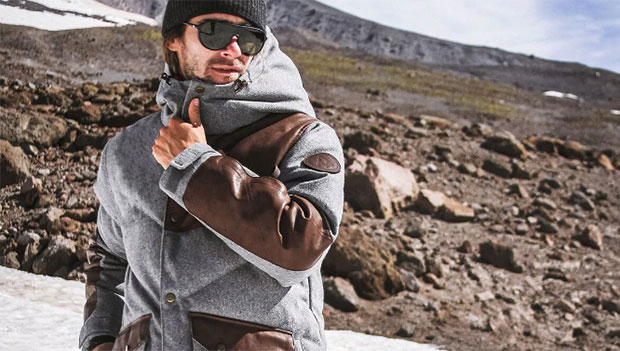
How do you prepare for a day on the slopes? Getting fit in the off season is one way. Finding the right ski jacket and other gear like gloves, helmet, goggles, and boots is another. Luckily, the apparel side of the ski industry is booming. Innovations in design, waterproofing, and materials have created nearly limitless options for professionals, enthusiasts, and first-time skiers, alike. In fact, there are so many stellar options that it can be overwhelming. There is no need to worry, though. We went through the avalanche of ski jacket choices so you don’t have to. Our expert-backed research will help you make an informed decision so you’ll be able to hit the slopes with confidence.
So what makes a ski jacket great? That answer depends on your purpose, budget, and location. Let’s start with a few key questions. Are you an amateur skier? A backcountry explorer? Is your skiing style casual or aggressive? Choosing the right jacket for your style of skiing will determine whether you have a ski day to remember or one you’d rather forget.
Our list below will help guide your ski jacket search and ensure you end up with one that suits your needs without going over budget.
Why Trust Us?
ACTIVE.com's editorial team relies on the knowledge and experience of fitness and wellness experts including competitive athletes, coaches, physical therapists, nutritionists, and certified trainers. This helps us ensure the products we feature are of the highest standard. Collectively, the team has spent countless hours researching equipment, gear, and recovery tools in order to create the most accurate, authentic content for our readers. Customer satisfaction is also a key part of our review process, which is why we only feature products that are highly rated. More importantly, each member of our team is a fitness enthusiast. Fitness may be our job, but it is also our passion. Therefore, we strive to bring you products that we trust and would personally use.
The Best Ski Jackets - Our Top Picks
By clicking on the product links in this article, we may receive a commission fee at no cost to you, the reader. Sponsorships and affiliate commissions help support our research so we can help you find the best products. Read our full affiliate disclosure here.
- Best Overall Ski Jacket: Outdoor Research Skytour AscentShell
- Best Ski Jacket for Women: Black Diamond Boundaryline
- Best Ski Jacket for Men: Helly Hansen Elevation Infinity 2.0
- Best Insulated Ski Jacket: Boulder Gear Eiger II Insulated Jacket
- Best 3-in-1 Ski Jacket: Helly Hansen Park City 3-in-1
- Best Budget Ski Jacket: Columbia Last Tracks Insulated Jacket
- Best Hardshell Ski Jacket: Black Diamond Recon Stretch Ski Shell
- Best Softshell Ski Jacket: Patagonia Upstride
- Best Ski Jacket for Beginners: Wildhorn Dover Premium
- Best High-end Ski Jacket: Alps and Meters Downhill '27
Styles of Skiing
There are three main styles of skiing: backcountry, resort or lift-service, and cross-country. Each comes with a specific set of needs. Let’s go through each style one by one so you can choose a jacket that aligns with your style.
Backcountry Skiing
If exploring the backcountry, skinning the untouched snow, and zigzagging among the trees sounds like your type of adventure, you’ll need a ski jacket that’s lightweight, abrasion resistant, and durable. It should be uninsulated, waterproof, and breathable. You’ll be hiking up slopes and breaking a sweat, so moisture management will be crucial. A hardshell ski jacket will be your go-to option for maximum weather protection, while a stretchable and breathable softshell jacket will be ideal if you’re looking for a superior range of motion. Some key features to look for are wrist gaiters, an adjustable hood with enough room for a helmet, pit zips, in-built RECCO for rescue detection in case of a catastrophe, and full seaming that leaves no gaps for water to slip in.
Resort/Lift-service Skiing
If you are heading to a ski resort and will be using the ski lift, an insulated ski jacket will best suit your needs. On a crowded day, you may find yourself waiting in line for the lift, and the ride to the top could be windy and chilly. An insulated ski jacket will trap heat close to your body so you’ll never be shivering. The insulation could be synthetic, duck or goose down, or PrimaLoft. Many insulated ski jackets also come with a ski pass pocket on the wrist.
Cross-country Skiing
Cross-country skiing is endurance-focused and is one of the sweatier styles of skiing. You should carry a ski jacket that's light, gives you freedom of movement, and captures your body heat so you don’t get cold on downhills. Softshell ski jackets are best suited for this type of skiing, as they are made of stretchable nylon or polyester and are quite lightweight. Make sure it's wind, water, and abrasion resistant in case you wipe out. It should fit well and should not flap around. Keep an extra insulating layer and/or an outer hard shell in case the weather takes a turn on you.
Things to Consider When Choosing a Ski Jacket
Type of Ski Jackets
Ski jackets vary by features, construction, and design, and the best jacket for you depends on your needs. Understanding the different types of ski jackets will help you arrive at the best decision and save you money. Below are the four types of ski jackets available on the market.
Insulated
As the word suggests, insulated ski jackets provide the highest degree of warmth and are ideal for resort skiers. They are one-piece, have an outer shell to protect from the weather, and are insulated from the inside to trap body heat. They are heavier than softshell and hardshell jackets, which means they would be too bulky for backcountry skiers. The price of insulated ski jackets depends upon the type and amount of insulation. Synthetic and down are two of the most common types of insulation. In especially snowy conditions, these jackets can be coupled with quality layers to provide extra warmth.
3-in-1s
3-in-1 ski jackets give the best bang for your buck, making them well suited for beginner skiers, budget seekers, and those looking for versatility. They are also ideal for price-conscious resort skiers. 3-in-1 ski jackets have a waterproof outer layer and a detachable insulated jacket which you can use on warm days or for hikes. The downside of these jackets is frequent sub-par construction and weight.
Softshell
Softshell ski jackets are stretchy, highly breathable, and reasonably warm. They are a perfect choice for backcountry skiing or resort skiing in milder weather. They are not fully waterproof but are water-resistant, making them a great choice for dry snow conditions. The absence of a waterproof membrane gives them a huge bump in breathability while also allowing a high degree of maneuverability. They often fit on the tighter side and can be easily paired with hardshell jackets in case the weather turns sour.
Hardshell
A hardshell ski jacket's main purpose is to keep the snow and rain out, making this style a strong choice for a variety of weather conditions. These are highly durable, windproof, and waterproof. They tend to be relatively thin and lightweight, making them easy to pack. They are a strong choice for backcountry and cross-country skiing which involve a lot of hiking and are full-body workouts. They are reasonably breathable, too. When it gets cold or snowy, a fleece or down jacket layered underneath will provide extra warmth.
Layers
There are generally two kinds of layering systems in a ski jacket: 2L and 3L. "L" stands for layer. The difference between the two usually comes down to weight and technicality.
- 2L: Starting with the outermost layer, 2L ski jackets have a hard outer shell, a hydrophobic membrane to seal out water, and a mesh lining on the inside to keep your skin away from the membrane. The outer layer is durable, textured, water-resistant, and can sometimes be colored. These are best for resort skiers who prioritize breathability and comfort.
- 3L: 3L ski jackets generally have an extra layer between your skin and the membrane to protect from wear and tear. They are best for backcountry skiers and are highly breathable and stiffer than 2L ski jackets. The 3L ski jacket's construction makes them a little expensive, but its versatile nature makes them a preferred choice for many high-performing and aggressive skiers.
Waterproofness
Waterproofness in ski jackets is measured in millimeters. The range is generally defined as under 5,000mm, 10,000mm, and above 20,000mm. Ski jackets under 5,000mm are best for skiing in light rain and on dry snow days. Waterproofing around 10,000mm is good for average rain and snow and lift-service skiing. Waterproofing above 20,000mm is best for aggressive skiing in heavy, prolonged rain and snow.
The outer layer of ski jackets is often coated in durable water repellent (DWR), which makes the water droplets bead up on top of it. DWR coatings are great, but ski jackets with waterproof breathable membranes, like the top-tier GORE-TEX membrane, are typically superior. Keep an eye out for waterproof seams and zippers that prevent water from seeping in.
Design
Today's ski jackets are loaded with features. For example, wrist gaiters with thumb holes keep snow out of your sleeves, high collars protect from wind and cold, RECCO integration allows rescuers to locate you in the event of an avalanche, pit zips add extra ventilation, and plenty of jackets come with helmet-compatible hoods that you can easily detach. Some feature external pockets for ski passes, internal pockets for phones and car keys, and shoulder pockets for even more storage.
One common feature among almost all ski jackets is the powder skirt. This is an extra flap that tightens around the hips for added warmth and can integrate with pants to keep the snow out in case of a fall.
Fit
Finding the right fit will come down to preference. Shell jackets that are trimmed to fit your body won’t create drag and will provide the mobility that aggressive and backcountry skiers need. Insulated ski jackets are built for resort skiing and offer more room for base layers underneath. Ski jackets should not be tight or feel stuffy, so it’s always worth trying one on if you have doubts about the sizing chart.
Weight
Ski jacket weight typically varies by type and price. Expensive ski jackets use high-quality lightweight materials, while cheaper jackets tend to use cheaper, heavier materials. Hardshell and softshell jackets are lighter in weight since they are uninsulated and designed for long days in the mountains and uphill travel. Insulated and 3-in-1 ski jackets are heavier due to their insulation. The 3-in-1 jackets are the heaviest of all.
Best overall - Outdoor Research Skytour AscentShell
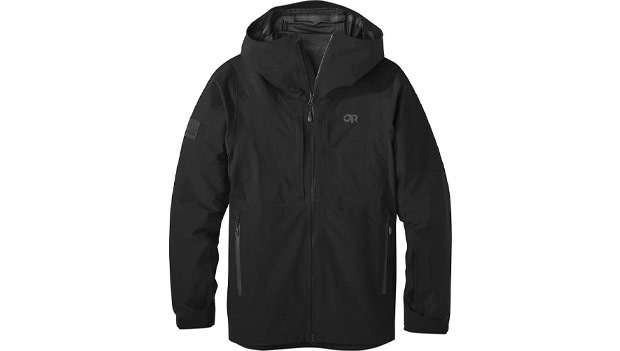
SPECS
- Type: Hardshell
- Material: 93% nylon and 7% spandex
- Weight: 627g
- Waterproof: 15,000mm
- Layers: 3-layer
The Outdoor Research Skytour AscentShell hardshell ski jacket takes the crown as the best overall ski jacket. It is highly versatile and affordable, offering many features on par with higher-priced jackets. The proprietary AscentShell technology makes it lightweight and highly breathable. The stretchy three-layer membrane is waterproof and air-permeable, making it a great choice for backcountry and cross-country skiers. The cut of this jacket is comfortable and provides substantial mobility to make ascents easy. Its seams are fully sealed to protect you from wet weather, and it has pit zips to offload extra heat in case it becomes a little toasty inside.
The features don’t stop there. This jacket offers multiple hood adjustments and a fantastic array of pockets. In total, there are seven pockets, including a forearm ski pass pocket with a key clip, a YKK Aquaguard zip to keep water out of the hand pockets, and an interior stash pocket. There is an adjustable drawcord hem for a snug fit and adjustable cuffs to seal out the weather and accommodate large gloves.
What We Like
- Lightweight
- Waterproof stretchy membrane
- Range of pockets
What We Don't Like
- No RECCO
- Non-removable hood
BUY: Outdoor Research Skytour AscentShell
Best Ski Jacket for Women - Black Diamond BoundaryLine

SPECS
- Type: Insulated
- Material: Polyester
- Weight: 765g
- Waterproof: 20,000mm
- Layers: BD.dry™ shell fabric and thermolite synthetic insulation
The Black Diamond BoundaryLine uses breathable shell fabric with Black Diamond's BD.dry™ waterproof tech, making it a great option for skiers even on damp days. The agility it provides is a result of the mechanical stretch technology built into the shell. The shell is DWR coated and it doesn't interfere with its moisture-wicking fabric.
Shivery temperatures are no match for the high-performing 60 grams of Thermolite synthetic insulation. Its seams are fully taped to keep water out. It comes with YKK Aquaguard zippered pockets, a helmet-compatible hood, an internal stretch powder skirt, pit zips, and a dual drawcord hem. Its durable finish, quick-drying qualities, and maneuverability make it a go-to ski jacket for snow carvers. At this price point, you will be hard-pressed to find another women’s ski jacket that comes close.
What We Like
- Breathable water protection, DWR finish
- Fully taped seams
- Super warm, protective construction
What We Don't Like
- Non-detachable hood
- No wrist gaiters
BUY: Black Diamond BoundaryLine
Best Ski Jacket for Men - Helly Hansen Elevation Infinity 2.0
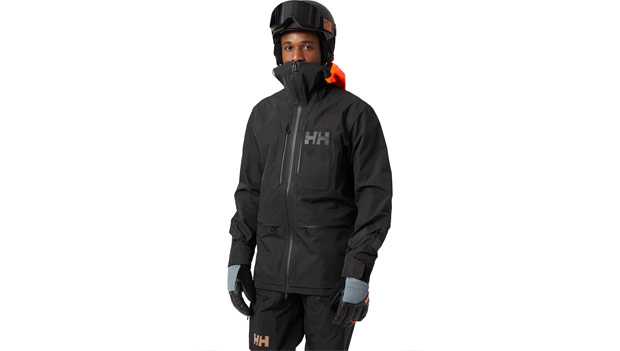
SPECS
- Type: Hardshell
- Material: Polypropylene
- Weight: 750g
- Waterproof: Exceptional hydrophobic LIFA Infinity Pro fabric
- Layers: 3-layer LIFA Infinity Pro
The innovative design, advanced construction, and proprietary technology used in the Helly Hansen Elevation Infinity 2.0 make it a highly reliable ski jacket that can handle high-performance skiing in almost all weather conditions. The outer shell is made of Helly Hansen’s award-winning LIFA Infinity Pro material, which creates a hydrophobic surface without the need for DWR treatment. Since it doesn’t rely on chemical treatment to make it waterproof, it is environmentally-friendly.
This jacket is a great option if you want to shred any line, anywhere while looking sustainably fashionable. The stretch powder skirt on the Elevation Infinity 2.0 is detachable and the roomy construction allows a helmet and backpack to fit underneath. The jacket features a built-in RECCO reflector and orange hood, aerogel insulation on the chest pocket to save your phone's battery, and a relaxed fit. Overall, it’s the ideal combination of waterproof, windproof, and breathable.
What We Like
- Highly waterproof
- Highly breathable
- Spacious and comfortable fit
What We Don't Like
- Stiffer on the sides
- Price point is quite high
BUY: Helly Hansen Elevation Infinity 2.0
Best Insulated Ski Jacket - Boulder Gear Eiger II Insulated Jacket
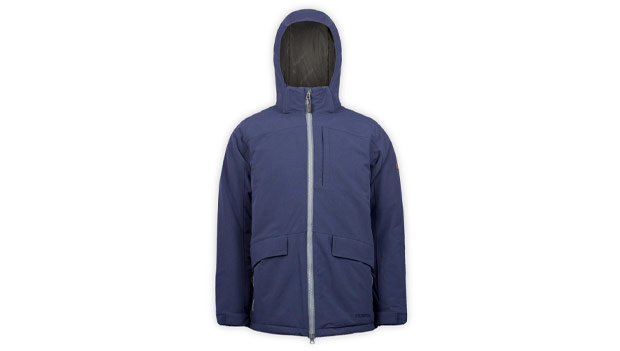
SPECS
- Type: Insulated
- Material: Polyester
- Weight: 750g
- Waterproof: 10,000mm
- Layers: 2-layer BG INCLINE
Boulder Gear makes tech-forward ski jackets at an affordable price. The Boulder Gear Eiger II Insulated Jacket packs 100 grams of PrimaLoft Black Eco synthetic polyester fibers into the sleeves and body and 80 grams into the collar and hood. This makes it capable of keeping you cozy at temperatures under 10 degrees Celsius. The 2-layer BG INCLINE membrane construction offers 10,000mm of waterproof protection without compromising breathability.
It also features pit zips, wrist gaiters, a quick-release adjustable hood, water-resistant YKK zippers, DWR surface finish, an internal powder skirt, and all the critical seams are sealed to water out. The rugged outer fabric is also highly durable and won’t scratch easily.
What We Like
- Degree of warmth
- Removable hood capability
- Quality insulation in sleeves and hood
- Highly affordable price point
What We Don't Like
- Non-removable powder skirt
- Water-resistance could be better
BUY: Boulder Gear Eiger II Insulated Jacket
Best 3 in-1 Ski Jacket - Helly Hansen Park City 3-in-1
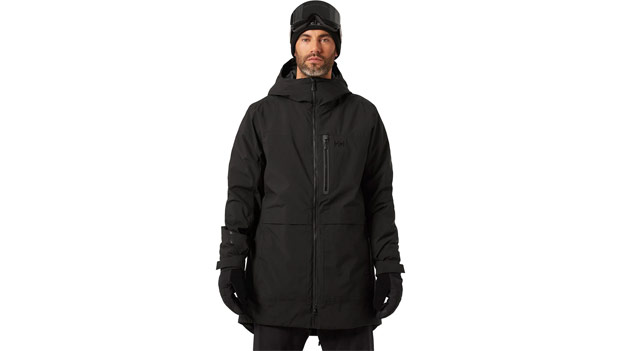
SPECS
- Type: 3-in-1 ski jacket
- Material: Polyester
- Weight: 1381g
- Waterproof: 25,000mm
- Layers: 3-layer with Helly Tech membrane
The Helly Hansen Park City 3-in-1 is a stylish ski jacket that excels in extreme cold. Its long design will keep you warm on chair lifts or on winter night walks around town. The removable inner jacket has 100 grams of PrimaLoft Black Eco insulation for a warm and comfortable feel, even in frigid conditions. The Helly Tech laminated membrane is waterproof and offers robust breathability. The Park City 3-in-1 features hand warmer pockets, a ski pass pocket, internal stash pockets, and a Life Pocket to save your phone or any electronic equipment batteries in cold conditions.
One of the great things about this ski jacket is that 80% of its insulation is recycled polyester. The polyester shell makes it durable, lightweight, and comfortable to slip into. Its removable powder skirt and wrist gaiters also help seal warmth inside.
What We Like
- Removable powder skirt
- Range of pockets
- Quality insulation in inner liner
What We Don't Like
- Unsealed seams
- Non-removable hood
- No pit zips
BUY: Helly Hansen Park City 3-in-1
Best Budget Ski Jacket - Columbia Last Tracks Insulated Jacket
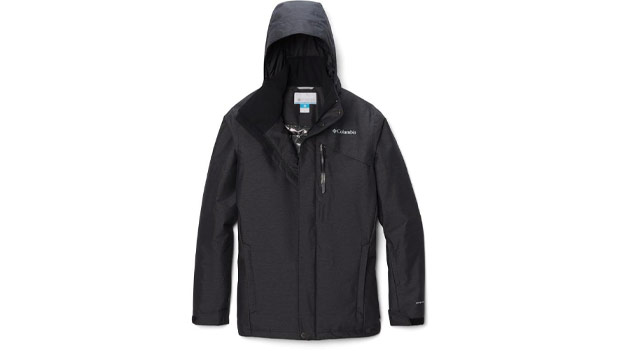
SPECS
- Type: Insulated
- Material: Nylon shell and polyester lining
- Weight: 970g
- Waterproof: 10,000mm (Omni-Tech waterproofing)
- Layers: Multi-layered waterproof and breathable construction
Columbia Last Tracks is an exceptional entry-level insulated ski jacket with loads of features and proprietary technology that won’t blow your budget. It’s a great choice for price-conscious skiers or those who prefer relaxed glides down the slopes. It has zippered chest pockets, a ski pass pocket, and an Omni-Tech waterproof membrane that wicks moisture. 80 grams of MicroTemp XF II synthetic insulation provide decent, lightweight warmth.
Inside, the Omni-Heat thermal reflective technology uses silver dots to prevent body heat from dispersing. For colder or stormy conditions, this jacket fares best with an extra base layer.
All of the critical seams are sealed, but this jacket doesn't have any pit zips, so dumping excess heat could be an issue.
What We Like
- Removable hood
- Lightweight
- Heat-reflective tech liner
What We Don't Like
- No ventilation
- Fitting
- No RECCO
BUY: Columbia Last Tracks Insulated Jacket
Best Hardshell Ski Jacket - Black Diamond Recon Stretch Ski Shell

SPECS
- Type: Hardshell
- Material: 84% nylon, 16% elastane
- Weight: 769g
- Waterproof: 20,000mm
- Layers: 3-layer BD.dry™
Black Diamond’s Recon Stretch Ski Shell jacket combines four-way stretch fabric with a waterproof, breathable membrane, making it a leader in functional mobility. It will keep snow out while you glide through the backcountry's dense powder. This extremely versatile ski jacket offers DWR-treated pit zippers in case you get too warm, a helmet-compatible hood, and a removable powder skirt for variable weather conditions.
The fit is relaxed and stylish. The seams are fully sealed to prevent any liquid seepage, and the jacket is so well-designed that it comes with a lifetime warranty. It is roomy enough to put on a base layer in especially cold conditions while six pockets offer ample storage. It is easy to pack and a reliable choice for backcountry or cross-country skiing.
What We Like
- 4-way stretch fabric
- Versatility
- Waterproofness and breathability
What We Don't Like
- No insulation
- No RECCO
- Smaller pockets
BUY: Black Diamond Recon Stretch Ski Shell
Best Softshell Ski Jacket - Patagonia Upstride
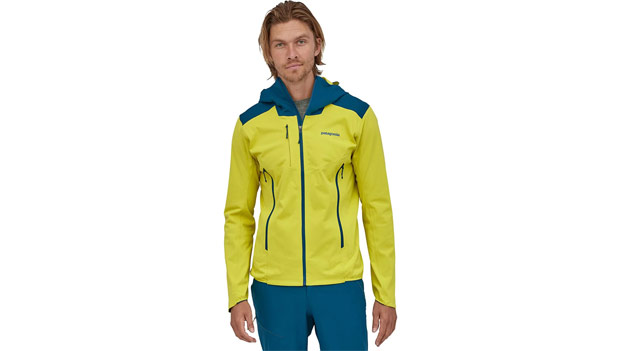
SPECS
- Type: Softshell
- Material: Recycled polyester
- Weight: 403g
- Waterproof: None (water-resistant)
Patagonia is a brand well-known for its commitment to sustainability, quality, and environment-friendly products. The Upstride softshell ski jacket is made from 100% recycled bonded stretch-knit outer fabric and a DWR finish that sheds moisture while remaining highly breathable. This jacket is made for predictable weather conditions. Its lightweight, stretchy, and moisture-wicking performance makes it suitable for fast uphill climbs and ski touring.
Two oversized chest pockets double as vents while an additional chest pocket will keep your essentials safe. A concealed built-in RECCO reflector will put your mind at ease, especially if you ski in avalanche-prone areas. This jacket has a laminated visor on the hood that is designed to work without a helmet for uphill skiing but will also accommodate low-profile helmets for downhill skiing.
What We Like
- Highly breathable
- Environment-friendly
- Comfortability
- Lightweight
What We Don't Like
- Not waterproof
- Fixed hood
BUY: Patagonia Upstride
Best Ski Jacket for Beginners - Wildhorn Dover Premium
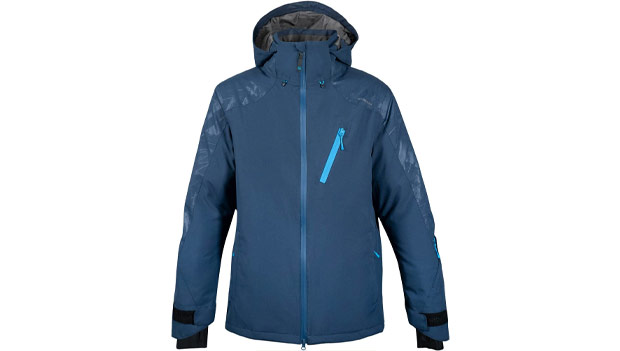
SPECS
- Type: Insulated
- Material: Polyester
- Weight: 1166g
- Waterproof: 12,000mm
- Layers: 2-layer
Wildhorn's Dover Premium ski jacket offers a range of options for new skiers who want to gain some experience on the slopes. It has a premium look at an affordable price and doesn’t skimp on features. 100 grams of polyfill insulation will keep you warm in icy conditions, while a DuPont DWR finish earns it a 12,000mm waterproof rating that will keep you dry. It is not the most breathable jacket, but its pit zippers will help you regulate body temperature.
The Dover Premium ski jacket is a superb choice for resort skiing. It has solid ergonomics, fits well, and features an easy access sleeve pass pocket on the left arm. With a base layer underneath, you’ll never run cold, and the integrated powder skirt will prevent snow from getting inside, even after a low-speed tumble on the bunny slope.
What We Like
- 2-way adjustable hood
- Quite affordable
- Adjustable hood, cuffs, and hem
- Offers pit zippers
What We Don't Like
- Not highly breathable
- No RECCO
Best High-end Ski Jacket - Alps and Meters Downhill '27

SPECS
- Type: Insulated
- Material: 50% lambswool, 50% polyester with leather panels
- Waterproof: 10,000mm
- Layers: 2-layer
Alps & Meters has a storied history that has been closely tied to alpine skiing since 1927. Their Downhill '27 jacket has an eye-catching design and elegant style that handles extreme cold and harsh ski conditions flawlessly. The high-loft 800-fill down insulation will give you unparalleled warmth and a lightweight feel. Packing it into a suitcase is no problem. The face fabric has a classy retro look with leather-panel pockets and a DWR finish.
In terms of features, this jacket is both water-repellent and windproof. It features wrist gaiters and a powder skirt to shield you from the cold. It has five pockets, including one zippered sleeve pocket for a ski pass. The hood is adjustable with a high neck design to protect against wind chill. Wear this on your next trip to a ski resort and you’ll turn heads as you glide in style.
What We Like
- Design and packability
- Exceptional warmth
- Odor resistant
What We Don't Like
- Non-removable powder skirt
- No pit zippers
BUY: Alps and Meters Downhill '27
FAQs About Ski Jackets
What kind of jacket should you wear skiing?
The kind of jacket you should wear depends on your skiing style. If you are a backcountry or cross-country skier, a lightweight jacket with good breathability will make the most sense. For resort skiing, you should opt for an insulated jacket. For any style of skiing, a jacket with features like a removable powder skirt, pit zips, RECCO, wrist gaiters, adjustable helmet-compatible hood, and a DWR finish will make sure you’re never uncomfortable.
Why are ski jackets so expensive?
Ski jackets are carefully crafted to protect you from unpredictable weather conditions in the mountains. Top-of-the-line ski jackets use the finest quality materials that are highly waterproof, highly breathable, lighter in weight, and they are often finished by hand. The time, technology, materials, and manpower all contribute to the cost of a ski jacket.
How many layers should you wear skiing?
If you are an aggressive skier who likes to push the limits, a two-layer hardshell or a softshell ski jacket will be sufficient. You can add a base layer underneath a jacket to stay warm in colder weather conditions. If you like to visit ski resorts, a three-layer jacket with strong insulation will keep you warm and protect you from moderately wet conditions.
How warm should my ski jacket be?
Your ski jacket should be able to protect you from temperatures between 5º and -20º Celsius. A ski jacket with around 600-fill down power is usually enough to keep you warm in most conditions. In the case of especially icy conditions, ski jackets above 700-down are a great option. Given your jacket is breathable and waterproof, it should be able to keep you warm in a range of conditions.
How long should a ski jacket last?
The life of a ski jacket could be a season or a decade. The process of degradation begins at the first contact with wet conditions. Over time, water-repellent DWR finishes and waterproofing will wear off and insulation will decrease. Of course, the quality of the ski jacket and the materials used in it will influence how long it lasts, but there are a few signs that a ski jacket is ready to be replaced. If it no longer keeps you warm or dry, you’re probably in the market for a new jacket.


